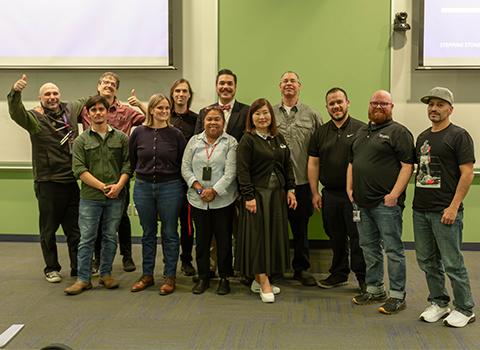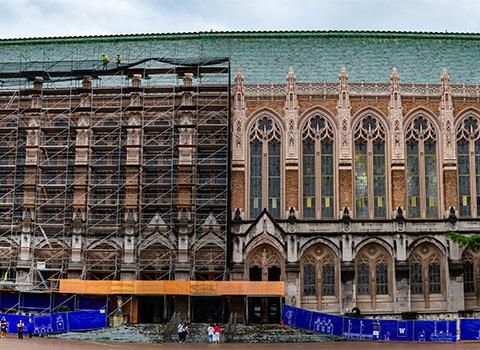Studying the UW's waste

Every 15 years, UW Recycling (of the Building Services Department) commissions a waste characterization study through Cascadia Consulting Group. The purpose of the study is to analyze the composition of the garbage produced at the University of Washington in Seattle — as well as how accurately UW sorts garbage, recycling and compost in bins across campus.
Why does waste matter?
Why does waste matter?
The 2018 study follows the same process as previous studies conducted in 1989 and 2003, but with an expansion in scope that now includes materials collected through recycling and compost streams. From January 29 through February 16, 2018, UW Recycling and Cascadia collected randomized samples and sorted over 38 tons of material. “We already track the amount of disposed material by waste stream on campus, but this study helps us find out is what we don’t know,” said UW Recycling Manager Liz Gignilliat. Such elements include:
-
How much of the material sent to the landfill could have been diverted?
-
What recyclables does campus generate and recycle both correctly and incorrectly?
-
What compostables does campus generate and compost both correctly and incorrectly?
-
Are there materials we throw away that could be diverted out of the garbage (if a new option was created instead)?
Results from this study help UW Recycling better serve campus with current diversion programs, identify realistic and achievable program goals, and support the design of effective diversion programs to achieve specific goals. The expanded scope allows UW Recycling to learn the capture rates of recyclable or compostable materials. For example, let's say campus discards a total of 12 pizza boxes a year. Because of the study, we can now plainly see that seven of them end up in the garbage and the remaining five are composted correctly.
The major takeaways of the study include:
- Compostable and food-soiled paper, like pizza boxes and napkins, are the top opportunity to reduce UW's landfilled material and reduce the recycling contamination rate
- Similarly, food is the top contaminant in the recycling
- Five times more low-grade recyclable paper (like junk mail) ends up in the garbage than in the recycling
- Over the last 15 years, food waste sent to the landfill has been reduced by 75%
We need to focus on cleaning up our recycling and compost — but particularly our recycling,” said UW Recycling Program Coordinator Holly Griffith. “Only 75% of our recycling is actually recyclable material campuswide right now. Almost 15% is compost and 8% is garbage. Part of that comes from needing our recyclables to be clean, empty and dry. Another part comes from wishful thinking, but either way we need to be more conscious of what we’re saddling recycling processors with,” said Griffith.

Left: A map indicating the buildings that were analyzed during the 2018 Waste Characterization Study.
Right: UW Recycling used Google Maps to identify external waste containers on campus.
The planning process
The planning process
Planning for the 2018 study took place in November 2017 through January 2018. Along with finalizing details like project scope, budget and updates, UW Recycling took on the challenge of updating the study’s criteria.
“Our campus has changed dramatically in the last 15 years, so we invested a lot of time in auditing the old list of buildings, figuring out all of their new names and locating their external waste containers,” said Gignilliat. “From there, we determined how they fit within the revised study, based on their current primary functions as generator groups.”
“We used Google Maps with color-coded pins to identify all external waste containers, especially since a great deal of sorting had to take place on-site, which involved BigBelly stations, litter cans, and recycling and compost bins.”
To better illustrate the study’s findings in an impactful way, UW Recycling turned to UW Lecturer and UW Sustainability Renewable Energy Liaison Marilyn Ostergren for her expertise in creating infographics. “Information visualization refers to presenting information in a form that lets us use vision, which is powerful and fast, rather than language, which is slower to understand,” said Ostergren.
“When we met with Marilyn, we shared our preliminary study results and how we hoped to create better visual interpretations so our information could be more accessible,” said Gignilliat. “Right then and there, we went to the drawing board with ways to organize the numbers.”
“Marilyn ran with it, tested graphs and provided new ideas we didn't even think were possible,” Gignilliat recalled. “These data visualizations break down information so it is not only understandable, but meaningful and actionable to the campus community.”

Left: An infographic illustrating what is thrown away on campus, and what bins are used. Right: An infographic demonstrating which generator groups compost food waste most accurately.
“The waste characterization study lets us understand ourselves and learn where we have room for improvement,” said Ostergren. “It can also show us how well we're doing — there's a lot of waste that isn't going to the landfill and that's great!”
UW Recycling plans to share the infographics as a means to educate both the campus and the public about waste behaviors. “We can achieve this by sharing the infographics with students working on research projects, present them at future conferences or display the information during one of our informational Trash Talks on campus,” said Gignilliat.
“The basics are still important,” said Griffith. “Take the time to recycle your paper products, to compost your food — that’s where we’re seeing the biggest disposal numbers and where we’ll see the biggest improvement when we can determine a solution.”
For more information or to have UW Recycling join your team for a specialized Trash Talk, contact recycle@uw.edu.



